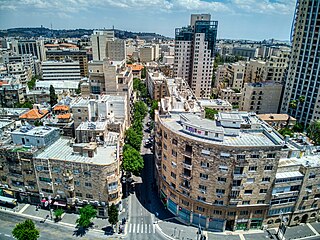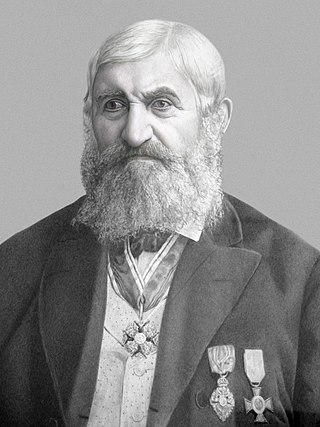
Bezalel Academy of Arts and Design is a public college of design and art located in Jerusalem. Established in 1906 by Jewish painter and sculptor Boris Schatz, Bezalel is Israel's oldest institution of higher education and is considered the most prestigious art school in the country. It is named for the Biblical figure Bezalel, son of Uri, who was appointed by Moses to oversee the design and construction of the Tabernacle. The art created by Bezalel's students and professors in the early 1900s is considered the springboard for Israeli visual arts in the 20th century.

The German Colony is a neighborhood in Jerusalem, established in the second half of the 19th century as a German Templer Colony in Palestine. Today the Moshava, as it is popularly known, is an upscale neighborhood bisected by Emek Refaim Street, an avenue lined with trendy shops, restaurants and cafes.

Mea Shearim is one of the oldest Jewish neighborhoods in Jerusalem outside of the Old City. It is populated by Haredi Jews, and was built by members of the Old Yishuv.

Batei Ungarin is a Haredi Jewish neighborhood in Jerusalem, north-east of the Old City of Jerusalem. It was built by Kolel Ungarin, a Hungarian Jewish charity supporting Jews living in the Land of Israel.

At-Tur is an Arab-majority neighborhood on the Mount of Olives approximately 1 km east of the Old City of Jerusalem. At-Tur is situated in East Jerusalem, occupied and later effectively annexed by Israel after the Six-Day War in 1967.

Kiryat HaYovel is a neighborhood in southwestern Jerusalem on Mount Herzl. It was built in the early 1950s to house new immigrants. Today, Kiryat HaYovel has a population of 25,000 residents.

Wadi al-Joz, also Wadi Joz, is a Palestinian neighborhood in East Jerusalem, located at the head of the Kidron Valley, north of the Old City of Jerusalem. The population of Wadi Joz is 13,000. It is located 750 meters above sea level in the Kidron Valley.

Ramat Eshkol is an Israeli settlement and neighborhood in East Jerusalem. It was built on land captured from Jordan in the Six-Day War and was the first neighborhood built in East Jerusalem after the Six-Day War in 1967. The international community considers Israeli settlements in East Jerusalem illegal under international law, but the Israeli government disputes this.

Romema is a neighbourhood in northwest Jerusalem, just off the Tel Aviv-Jerusalem highway at the main entrance to the city. It occupies the highest hill in Jerusalem. Romema is bordered by Kiryat Mattersdorf and Mekor Baruch.

Beit Safafa is a Palestinian town along the Green Line, with the vast majority of its territory in East Jerusalem and some northern parts in West Jerusalem.

The Bukharan Quarter, also HaBukharim Quarter or Bukharim Quarter, is a neighborhood in the center of Jerusalem, Israel. The neighborhood was established by Bukharan Jews of the Old Yishuv. The neighborhood also anchored communities from modern-day Afghanistan and the Iranian city of Meshad. It belonged to the early Jewish neighborhoods built outside the Old City of Jerusalem as part of a process which began in the 1850s. Today most of the residents are Haredi Jews.

Hillel Street is one of the central streets of Jerusalem. It connects King George Street to the small Ben Sira Street and the Mamilla neighbourhood and is parallel to Ben Yehuda Street. The lower part of the road is between Independence Park and the Nahalat Shiva neighborhood.
Neve Granot is a neighborhood in Jerusalem located behind the Israel Museum, overlooking the Monastery of the Cross.

Conrad Schick (1822–1901) was a German architect, archaeologist and Protestant missionary who settled in Jerusalem in the mid-nineteenth century. For many decades he was head of the "House of Industry" at the Christ Church, which was the institute for vocational training of the London Society for Promoting Christianity Amongst the Jews.

Ramot Polin is a part of the Israeli settlement of Ramot, in northwest East Jerusalem. It was constructed by the Kollel Polen (Poland) in stages beginning in 1972, under the auspices of the Office for Building and Habitation, and is populated, as intended, mostly by Haredi Jewish families, including Breslov. The neighborhood contains 720 housing units of varying sizes.

Street of the Prophets is an east–west axis road in Jerusalem beginning outside Damascus Gate and ending at Davidka Square. Located to the north of Jaffa Road, it bisects the neighborhood of Musrara.

Conrad Schick Library is a small research library located at the Christ Church, in Jerusalem.

The Swedish Theological Institute (STI) is an institute in Jerusalem supported by the Church of Sweden. Christian students of theology can gain a deeper understanding of Judaism at the Institute, and also of Christianity and Islam.

Even Yisrael is a former courtyard neighborhood in Jerusalem. Built in 1875, it was the sixth Jewish neighborhood to be established outside the Old City walls. It is now part of the Nachlaot neighborhood. In 2004 the neighborhood underwent preservation and renovation by the Jerusalem Municipality, which re-paved and re-landscaped the central courtyard and added a small stone amphitheater for tour groups and daytime passersby.

Zikhron Tuvya, also spelled Zichron Tuvia, is a former courtyard neighborhood in Jerusalem. Founded in 1890, it was the twenty-third Jewish neighborhood to be established outside the Old City walls. The neighborhood consisted of parallel row-houses facing each other across a wide street, today named Zikhron Tuvya Street. Initially populated by tradesmen and workshops, it became a residential neighborhood after the 1920s. It is now part of the larger Nachlaot neighborhood.



















